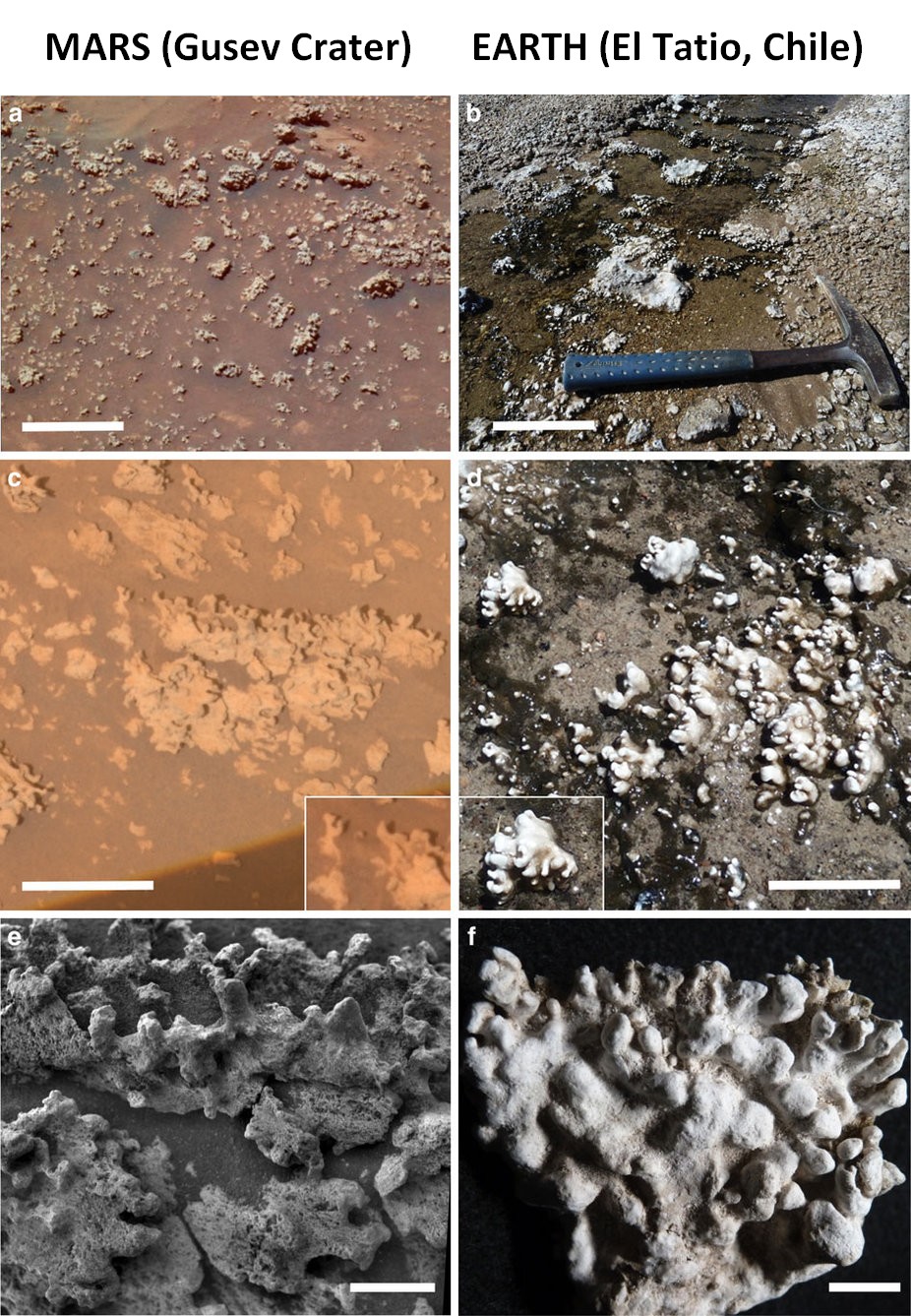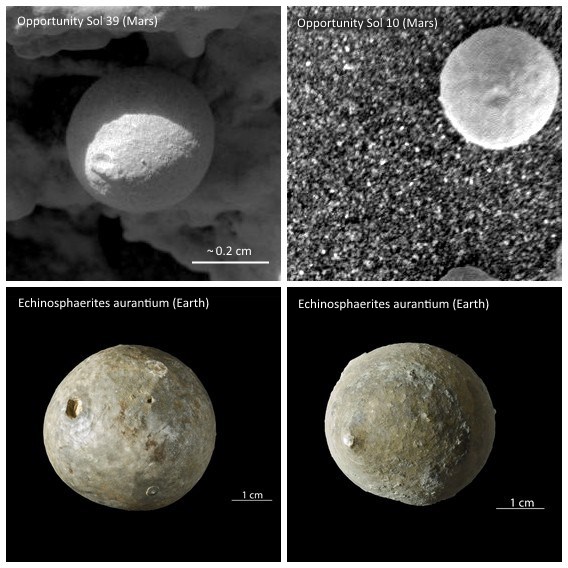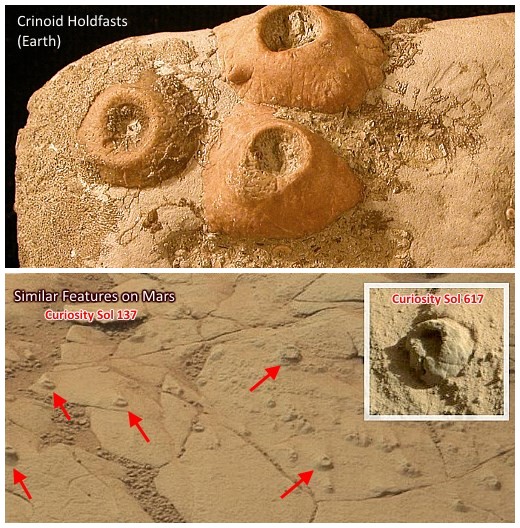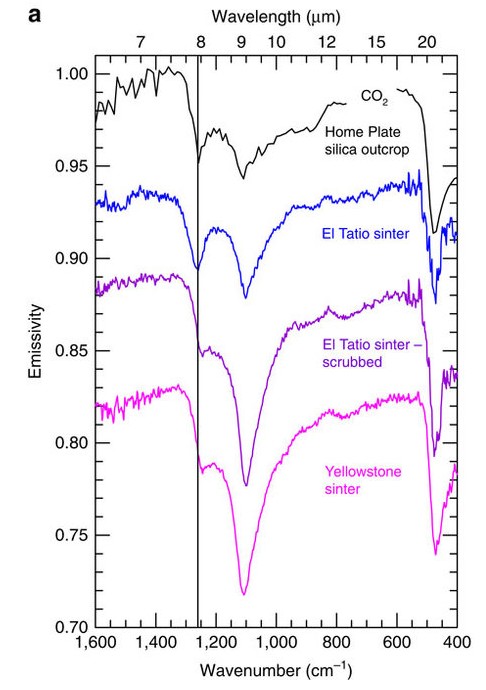It looks like you're using an Ad Blocker.
Please white-list or disable AboveTopSecret.com in your ad-blocking tool.
Thank you.
Some features of ATS will be disabled while you continue to use an ad-blocker.
29
share:
Geoscientists Steven Ruff and Jack Farmer from Arizona State University have identified what they believe to be biosignatures on Mars by comparing
rover images of Martian formations with similar geological features on Earth (the Chilean hot springs at El Tatio). If they are right, then biological
life forms were once present on the surface of Mars and a second Genesis indeed took place beyond planet Earth in the distant past!
This might not sound like big news for many on this board, but for those of us who passionately sifted through hundreds of Mars images, hunting for hints of past life on Mars, this corroborative evidence is the kind of confirmation we were hoping for. Ruff and Farmer recently published their findings on nature.com. Here goes an excerpt from their paper/article:
The special thing about their comparison is that hydrothermal spring deposits of silica are known to be capable of capturing and preserving biosignatures. Ruff and Farmer took into account the whole geological context of the area around Home Plate (the landing site of Spirit rover) arguing that it shows all the signs of past volcanic hydrothermal activity.
The reason why it took so long to publish findings like these, considering the rather old rover images and measurements, is probably that it's not easy to find a spot on Earth with similar conditions (volcanic hydrothermal activity) that mimics the landing site of Spirit. But that's also why this is so exciting: Ruff and Farmer provide an in-depth analysis of nodular masses with digitate structures (see image below) that are found both on Mars and Earth. These are known to form under the presence of water and microbial communities.

They go on to describe in great detail the similar surface textures seen in microscopic images of such structures on Mars and Earth. For non-geologists, like myself, their detailed descriptions are rather difficult to comprehend but it all seems legit and thoroughly executed (not to mention that it has been published by Nature). Having drawn a variety of comparisons (involving microscopic/spectral analysis) between features at El Tatio and Home Plate, they come to the conclusion that "The morphology of Home Plate digitate silica structures bears a strong resemblance to the microbially mediated microstromatolites at El Tatio."
Boom! Such Stromatolites would testify that there was once life on Mars. It would mean nothing less than that a second genesis had taken place on another planet. And it raises further questions about the transition from microbial life to more complex life for which we already found visual indications in other rover images:


And last but not least, let's not forget Richard Hoover's infamous fossil at Eagle crater. Will he have been right about past life on Mars all along? I'm sure he's already celebrating these recent findings with a bottle of good champagne. For more information about potential fossils on Mars (especially crinoids and spherules such as Echinosphaerites) also see these previous threads:
www.abovetopsecret.com...
www.abovetopsecret.com...
So if Farmer and Ruff think they have found biosignatures left behind by biological processes in the Martian past (and both are specialists in the field), then I would assume they are right? What do you think? I very much look forward to your opinions, thoughts and ideas...
SOURCES AND LINKS:
------------------------------------------
1. Silica deposits on Mars with features resembling hot spring biosignatures at El Tatio in Chile
2. Figure: Comparison of opaline silica structures adjacent to Home Plate with those of hot spring discharge channels at El Tatio
3. Professor Jack D. Farmer / Arizona State University
4. Professor Steven Ruff / Arizona State University
5. Related article on www.astrobio.net
5. Looking for life on Mars — in Chile
6. Image source: Silica deposits in Chile / Mars
7. Image source: Spirit home plate (large)
8. Stromatolites / Wikipedia
This might not sound like big news for many on this board, but for those of us who passionately sifted through hundreds of Mars images, hunting for hints of past life on Mars, this corroborative evidence is the kind of confirmation we were hoping for. Ruff and Farmer recently published their findings on nature.com. Here goes an excerpt from their paper/article:
Source article (nature.com)
The Mars rover Spirit encountered outcrops and regolith composed of opaline silica (amorphous SiO2·nH2O) in an ancient volcanic hydrothermal setting in Gusev crater. An origin via either fumarole-related acid-sulfate leaching or precipitation from hot spring fluids was suggested previously (...)
Here we report remarkably similar features within active hot spring/geyser discharge channels at El Tatio in northern Chile, where halite-encrusted silica yields infrared spectra that are the best match yet to spectra from Spirit. Furthermore, we show that the nodular and digitate silica structures at El Tatio that most closely resemble those on Mars include complex sedimentary structures produced by a combination of biotic and abiotic processes. Although fully abiotic processes are not ruled out for the Martian silica structures, they satisfy an a priori definition of potential biosignatures.
The special thing about their comparison is that hydrothermal spring deposits of silica are known to be capable of capturing and preserving biosignatures. Ruff and Farmer took into account the whole geological context of the area around Home Plate (the landing site of Spirit rover) arguing that it shows all the signs of past volcanic hydrothermal activity.
The reason why it took so long to publish findings like these, considering the rather old rover images and measurements, is probably that it's not easy to find a spot on Earth with similar conditions (volcanic hydrothermal activity) that mimics the landing site of Spirit. But that's also why this is so exciting: Ruff and Farmer provide an in-depth analysis of nodular masses with digitate structures (see image below) that are found both on Mars and Earth. These are known to form under the presence of water and microbial communities.

They go on to describe in great detail the similar surface textures seen in microscopic images of such structures on Mars and Earth. For non-geologists, like myself, their detailed descriptions are rather difficult to comprehend but it all seems legit and thoroughly executed (not to mention that it has been published by Nature). Having drawn a variety of comparisons (involving microscopic/spectral analysis) between features at El Tatio and Home Plate, they come to the conclusion that "The morphology of Home Plate digitate silica structures bears a strong resemblance to the microbially mediated microstromatolites at El Tatio."
Boom! Such Stromatolites would testify that there was once life on Mars. It would mean nothing less than that a second genesis had taken place on another planet. And it raises further questions about the transition from microbial life to more complex life for which we already found visual indications in other rover images:


And last but not least, let's not forget Richard Hoover's infamous fossil at Eagle crater. Will he have been right about past life on Mars all along? I'm sure he's already celebrating these recent findings with a bottle of good champagne. For more information about potential fossils on Mars (especially crinoids and spherules such as Echinosphaerites) also see these previous threads:
www.abovetopsecret.com...
www.abovetopsecret.com...
So if Farmer and Ruff think they have found biosignatures left behind by biological processes in the Martian past (and both are specialists in the field), then I would assume they are right? What do you think? I very much look forward to your opinions, thoughts and ideas...
SOURCES AND LINKS:
------------------------------------------
1. Silica deposits on Mars with features resembling hot spring biosignatures at El Tatio in Chile
2. Figure: Comparison of opaline silica structures adjacent to Home Plate with those of hot spring discharge channels at El Tatio
3. Professor Jack D. Farmer / Arizona State University
4. Professor Steven Ruff / Arizona State University
5. Related article on www.astrobio.net
5. Looking for life on Mars — in Chile
6. Image source: Silica deposits in Chile / Mars
7. Image source: Spirit home plate (large)
8. Stromatolites / Wikipedia
edit on 25-11-2016 by jeep3r because: text
Very cool.
My questions though would be:
1) Does it really mean a second genesis? I thought it had been shown it is possible (but unlikely) for life to have moved to/from Earth/Mars riding on the ejecta from a comet or asteroid impact? So maybe life started there, and then came here (or the other way around).
2) If #1 above is NOT the case, and it was a second genesis, doesn't that mean that life on the two planets would not necessarily be similar, and just because formations on Mars look like some formations on Earth that we can't say it because of microbes/life?
Gotta get some feet (and brains) on Mars
My questions though would be:
1) Does it really mean a second genesis? I thought it had been shown it is possible (but unlikely) for life to have moved to/from Earth/Mars riding on the ejecta from a comet or asteroid impact? So maybe life started there, and then came here (or the other way around).
2) If #1 above is NOT the case, and it was a second genesis, doesn't that mean that life on the two planets would not necessarily be similar, and just because formations on Mars look like some formations on Earth that we can't say it because of microbes/life?
Gotta get some feet (and brains) on Mars
a reply to: jeep3r
thanks Jeep, maybe now some Russian hackers or some stray science editor will take the time to go through every post on your Mars anomalies threads (thousands of posts) to find the best Curiosity Rover candidates, and then submit them to geologists and experts in other fields. Lots of good finds in there, especially on the smaller scale.
Maybe you could pop some links to the rolling anomaly threads and some of the better substantial individual threads at some point on this thread.
thanks Jeep, maybe now some Russian hackers or some stray science editor will take the time to go through every post on your Mars anomalies threads (thousands of posts) to find the best Curiosity Rover candidates, and then submit them to geologists and experts in other fields. Lots of good finds in there, especially on the smaller scale.
Maybe you could pop some links to the rolling anomaly threads and some of the better substantial individual threads at some point on this thread.
edit on 25-11-2016 by Aleister because: (no reason given)
Great thread, SnF
We don't know as much about this planet, as we think we do, yet we are already exploring our neighbour and capturing lots of important data.
We don't know as much about this planet, as we think we do, yet we are already exploring our neighbour and capturing lots of important data.
originally posted by: Aleister
a reply to: jeep3r
thanks Jeep, maybe now some Russian hackers or some stray science editor will take the time to go through every post on your Mars anomalies threads (thousands of posts) to find the best Curiosity Rover candidates, and then submit them to geologists and experts in other fields. Lots of good finds in there, especially on the smaller scale.
Maybe you could pop some links to the rolling anomaly threads and some of the better substantial individual threads at some point on this thread.
You're welcome, Aleister. It all kind of supports the idea that some of the features we previously found could be more than just rocks. I'm sure this thread is the ideal place to throw in images of the more notable anomalies from previous posts.
It's also noteworthy that these guys managed to find such evidence without requiring "boots on the ground"! Of course, their findings make the prospect of actually going to Mars even more interesting.
originally posted by: TommyD1966
1) Does it really mean a second genesis? I thought it had been shown it is possible (but unlikely) for life to have moved to/from Earth/Mars riding on the ejecta from a comet or asteroid impact? So maybe life started there, and then came here (or the other way around).
2) If #1 above is NOT the case, and it was a second genesis, doesn't that mean that life on the two planets would not necessarily be similar, and just because formations on Mars look like some formations on Earth that we can't say it because of microbes/life?
More than anything we've had before, this qualifies as serious evidence for biosignatures and implies that a second genesis took place on Mars. There were many indications on images before showing what seemed to be features of biological origin BUT:
- we know that NASA, JPL and other institutions never officially talked about such "evidence"
- this is the first detailed paper in a magazine like Nature claiming to have found said evidence
- everything else, like panspermia or microbial life on Mars was only theory, not evidence
If I, as an anonymous guy on the internet, claim to see something of biological origin in a Mars image, that's a nice claim but will hardly be considered by any serious scientist. If geologists, mineralogists/astrobiologists claim something similar in a recognized science publication (supported by much more data), then that's huge news.
Morphological evidence is shaky at best, as has been shown with the infamous ALH84001
meteorite. Just because something looks like a certain something, doesn't necessarily mean it is indeed that "certain something".
The question is, are the said formations in Gusev crater really biosignatures, or completely non-biologically formed geological features?
The question is, are the said formations in Gusev crater really biosignatures, or completely non-biologically formed geological features?
a reply to: wildespace
I understand the caution, but it's not purely morphological since they also looked into Spirit's APXS spectra of certain features at Home Plate (see here). I don't claim that I can interpret the data correctly, but they write:
The morphology of the site is also determined by its context and past microenvironmental conditions. There's another comparison showing that the surface textures are indeed eerily similar at both sites (see here).
That's why they strongly tend to explaining the features with biosignatures rather than chemical processes. Being the good scientists that they are, they of course considered a purely non-biological origin as well but discarded it as unlikely.
I understand the caution, but it's not purely morphological since they also looked into Spirit's APXS spectra of certain features at Home Plate (see here). I don't claim that I can interpret the data correctly, but they write:
... the appearance of a strong ∼1,260 cm−1 feature in halite-encrusted sinter samples is enigmatic and apparently has not been documented previously.
The morphology of the site is also determined by its context and past microenvironmental conditions. There's another comparison showing that the surface textures are indeed eerily similar at both sites (see here).
That's why they strongly tend to explaining the features with biosignatures rather than chemical processes. Being the good scientists that they are, they of course considered a purely non-biological origin as well but discarded it as unlikely.
edit on 26-11-2016 by jeep3r because:
text
a reply to: moebius
Quite right and rather wise to mention that, but I think we should also consider the following:
"The hypothesis that they are microstromatolites arises from our interpretation of the integrated observations of geologic context, mineralogy and morphology down to mm-scale, all of which are consistent with a microbialite origin" (also quoting the paper).
Quite right and rather wise to mention that, but I think we should also consider the following:
"The hypothesis that they are microstromatolites arises from our interpretation of the integrated observations of geologic context, mineralogy and morphology down to mm-scale, all of which are consistent with a microbialite origin" (also quoting the paper).
edit on 28-11-2016 by jeep3r
because: text
originally posted by: jeep3r
a reply to: moebius
Quite right and rather wise to mention that, but I think we should also consider the following:
"The hypothesis that they are microstromatolites arises from our interpretation of the integrated observations of geologic context, mineralogy and morphology down to mm-scale, all of which are consistent with a microbialite origin" (also quoting the paper).
A hypothesis is indeed all they've got.
Morphology only gets you so far...
new topics
-
A call to repentance—God is patient, but His patience does not abide forever.
Religion, Faith, And Theology: 7 hours ago -
My Pet Elephant For A Day…
Short Stories: 7 hours ago -
Congress 2024 - We do not want me in our ladies rooms
US Political Madness: 7 hours ago
top topics
-
A Question for You on the Left
Political Ideology: 14 hours ago, 18 flags -
Dr Cambell talking about using worm meds for cancer
Medical Issues & Conspiracies: 13 hours ago, 14 flags -
Looks like Biden kicked off WWIII and Putin threatening nukes to retaliate
World War Three: 15 hours ago, 9 flags -
Congress 2024 - We do not want me in our ladies rooms
US Political Madness: 7 hours ago, 8 flags -
My Pet Elephant For A Day…
Short Stories: 7 hours ago, 6 flags -
Words of Wisdom from the Dear Leader - Transcribed for the World
Regional Politics: 15 hours ago, 4 flags -
A call to repentance—God is patient, but His patience does not abide forever.
Religion, Faith, And Theology: 7 hours ago, 2 flags
active topics
-
-@TH3WH17ERABB17- -Q- ---TIME TO SHOW THE WORLD--- -Part- --44--
Dissecting Disinformation • 3315 • : 777Vader -
Well, here we go red lines crossed Biden gives the go ahead to use long range missiles
World War Three • 241 • : yuppa -
DefCon Teetering on Escalation
World War Three • 43 • : NorthOS -
A Question for You on the Left
Political Ideology • 40 • : atsalex2 -
Congress 2024 - We do not want me in our ladies rooms
US Political Madness • 4 • : matafuchs -
President-Elect DONALD TRUMP's 2nd-Term Administration Takes Shape.
Political Ideology • 224 • : WeMustCare -
Incoming TRUMP Admin will Declare a National Emergency to Mass Deport People Here Illegally.
Social Issues and Civil Unrest • 113 • : WeMustCare -
Former DOJ charged with defrauding Rep. Matt Gaetz’s family over sex-crimes investigation
Propaganda Mill • 38 • : WeMustCare -
President-elect TRUMP Picks MATT GAETZ for his ATTORNEY GENERAL - High Level PANIC Ensues.
2024 Elections • 104 • : WeMustCare -
WATCH LIVE: US Congress hearing on UFOs, unidentified anomalous phenomena
Aliens and UFOs • 137 • : WeMustCare
29

